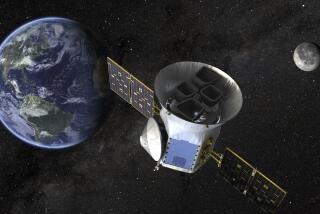Why scientists are surprised by this strange giant planet and its three suns
In a strange solar system 320 light years from our own, scientists have spotted a planet with three suns that rise in the morning and set at night.
Luke Skywalker’s two-sunned home planet of Tatooine has nothing on this real-life world in our own galaxy.
The newly discovered planet is described Thursday in the journal Science.
Researchers say the planet, called HD 131399Ab, is roughly four times the size of Jupiter and 16 million years old. That makes it a very young planet in the context of the universe. The Earth, for example, is 4.5 billion years old.
Scientists say it takes 550 years for the planet to complete its journey around the biggest star in the system, which is 80% more massive than our sun.
The planet’s other two suns are tightly linked in an 18-year orbit around each other. The larger of these two stars is about the same size as our sun, the other is just a little more than half that size.

An artist’s impression shows the orbit of the planet in the triple star system HD 131399. Two of the stars are close together and the third is orbited by a gas giant planet named HD 131399Ab. (L. Calçada/M. Kornmesser / ESO)
For one-half of the planet’s long year, all three suns rise in the morning and set in the evening. For the other half of the year, the two smaller suns rise just as the large sun sets, providing this planet an endless day.
“You can imagine the triple sunrises and triple sunsets occur when the planet is opposite all three stars,” said Kevin Wagner, a PhD student at the University of Arizona and the first author on the paper. “But when it is in between them, the single star and the tight binary stars will grow in apparent separation in the sky until the setting of the large star coincides with the rising of the other two stars.”
He added that each of these seasons would last longer than a human lifetime.
Triple-star systems may seem exotic to us, but researchers say multistar systems are just as common as single-star systems throughout the cosmos.
What makes the discovery so surprising is that the planet is so close to all its stars, Wagner said.
See the most-read stories in Science this hour »
The planet 51 Eri b, for example, is also located in a triple-star system, but while it is just 13 times the distance between the Earth and the sun from one of its stars, it is about 2,000 times that distance from its other two stars. That makes it more reminiscent of a planet orbiting a single star.
The planet Wagner found is 80 times the distance between the Earth and the sun from the largest star in the system, and just 300 times that distance from the other two stars.
Scientists weren’t even sure that a planet could have a stable orbit in this type of stellar arrangement because the complex gravitational forces from the relatively close other two stars could cause it to be ejected from the system.
“This discovery shows us that planets can form or evolve into these almost unstable systems that previously almost seemed like science-fiction,” Wagner said.
The planet was first spotted with the SPHERE instrument on ESO’s Very Large Telescope in June 2015. The discovery was part of a survey to look for long-period planets in orbit around young stars.
Do you love science? I do! Follow me @DeborahNetburn and “like” Los Angeles Times Science & Health on Facebook.
ALSO
With gold and rat heart cells, scientists make a robot stingray
Researchers develop genetic test that can predict your risk of Alzheimer’s disease
4 in 10 top-selling sunscreens on Amazon don’t meet dermatologists’ standards, study says






